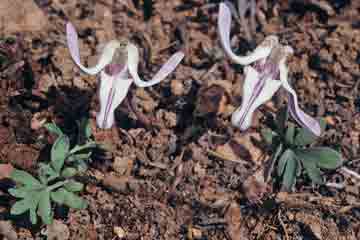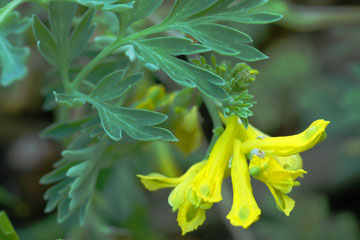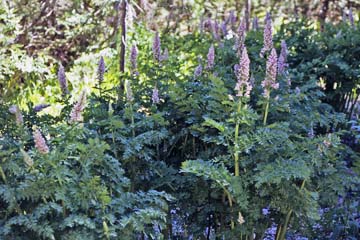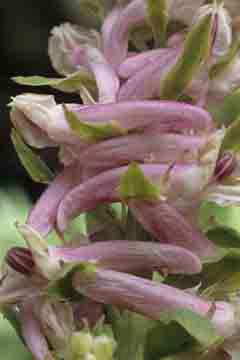Home | Next |
Previous |
Index | Purchase
book
Idaho Mountain Wildflowers
The Fumitory (Bleeding Heart) Family: Fumariaceae:
The Fumitory's family name, Fumariaceae, is derived
from the name of a common European plant Fumaria officianalis, a
plant that grows in the United States only as a garden escape. Members of
the genus are known as "fumitorys," a term that seems to have been derived
from the latin terms fumus = smoke + terrae = of the earth,
possibly because the European plant has a wispy, amorphous growth pattern.
Flowers in this family are bilaterally symmetrical and four petaled. Because
of their unusual forms, however, the petals may be hard to delineate—as
in bleeding heart (Dicentra formosa (Haw.) Walp.) and dutchman’s
breeches (D. cucullaria (L.)Bern. (neither shown here), both are found
in the northwest although only the latter grows in Idaho at lower elevations
in the Columbia River drainage.
 |
The Steer’s head, Dicentra
uniflora Kellogg (left), has
horns formed by two upper petals, and an elongated head formed by two
lower ones, is aptly named. It blooms early in the spring at montane to subalpine
elevations. Steer’s heads are not rare they are elusive. Look for them
on rocky hillsides below snowline. They are small and often grow in sagebrush,
so finding one is usually a matter of chance.
The Golden corydalis, Corydalis aurea
Willd. (right), is an attractive sprawling plant with
short-lived yellow flowers. It growss at least as high as the montane
zone. The plant can be identified by its tubular flowers, each with two inner
petals. One of the outer petals forms a fringed crest over the opening of
the flower tube and extends backward to form a prominent spur. The plant’s
grayish-green leaves are basically pinnate, although the leaflets divide
again (i.e., they're “bipinnate”). Corydalises have exploding seed
capsules that broadcast many small seeds.
|
 |
 |
Cusick’s fitweed, Corydalis
caseana A. Gray var. cusickii (S. Watson)
C. L. Hitchc. (right, left). Cusick’s fitweed (or
corydalis) is an uncommon, high montane to subalpine streamside plant that
blooms in early summer. Its small flowers have an upper petal that forms
a long backward spur that extends as a hood over the front of the flower.
This, joined to a lower petal, creates a flower tube that contains two darker
inner petals. A tight cluster of fifty or so of these small purple flowers
tops each stem. Its densely clustered flowers, its fern-like compound leaves,
and its height make it an impressive plant. Sheep that graze on fitweeds
die in convulsions, explaining its common name. Botanist Asa Gray named the
species in 1874, giving it the species name caseana, to honor Eliphalet Lewis
Case, (1843-1925), a California schoolteacher, Civil War veteran, and occasional
plant collector who found the plant. |
 |
Home | Next |
Previous |
Index | Purchase
book



